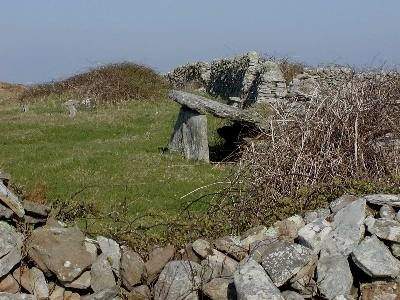county list
|
Turn smartphone to horizontal
view. SELECTED SITES IN COUNTY LEITRIM Place-names in italics refer to listed entries. Convert Irish Grid references to Latitude/Longitude |
|
click
for more
Situated on the gradual
E slope of Truskmore Mountain, and set in significant scenery,
this is one of several megalithic tombs to be discovered recently.
Located on rough ground on the edge of a limestone pavement,
it is an almost-intact wedge-tomb with all the classic characteristics
of kerb, double-walling and portico or antechamber, though it
is only just emerging (thanks to Global Warming) from the peat.
A chain around one of the roofstones suggests that some vandal
recently has tried to dismantle it. ~ Some 200 metres E, on the opposite side of the exposed limestone pavement (G 802 444) is a long cairn (41 metres) aligned North and South with four bumps suggesting 4 tombs or chambers in a row. At the N end a couple of upright slabs still stand. ~ A little over 400 metres NNW at G 799 447 in Tawnamachugh is a wrecked portal-tomb in a cairn some 65 metres long. Near it is also a wrecked court-tomb. ~ 6.8 km NNW are the two tombs at Shesknan. ~ Just under 12 km NE is the well-preserved court-tomb at Shasgar. Annaghmore:
Portal-tomb Of this very attractive little tomb my colleague of megalithomania.com writes: "It is situated in a little roadside niche under a nice big tree. The capstone (2 metres x 1.6 metres ) is wonderfully bumpy and featuresome (now there's a new word!) and oh so very, very tactile. The whole thing is wonderfully intact, with some minor collapsing of one of the chamber walls. The two portal stones highlight a great architectural feature of the tomb. The capstone is stepped along the front edge and to compensate for this the portal stones are of unequal height (1.6 metres and 1.3 metres), thus making the capstone level. Brilliant!" ~ 1 km NNW in Drumconny (N 135 955) a stone circle is reported, about which I have no information at present. ~ 4 km NE in Sunnagh More (N 152 979) is a ruined wedge-tomb, of which only a large sill-stone and side-stones remain, with traces of double-walling and much cairn-material. ~ 8 km NE at Aghavas (N 185 010) a portal-tomb is reported, about which I have no information at present. ~ 4 km WNW in Cloonlaughil (N 110 956, Sheet 33) is a court-tomb with an almost intact court some 4 metres wide and 3 metres deep, and a three-chambered gallery some 4 metres long. Little else survives. ~ 5 km WSW in Clooncoe (N 105 925, Sheet 33) is a mysterious megalith, like a kist-tomb with attached standing-stone/grave-marker. A roof-slab 1.8 metres square is supported on low stones to form a small chamber. Adjoining the E end is a leaning, round-topped slab 2.2 metres tall and 1.3 metres wide, giving the megalith the appearance of a chair.
Corracloona:
Single-court tomb About 30 metres W of
the road from Glenfarne to Kiltyclogher, this fine and unusual
tomb has a large door-slab in which is a "kennel-hole" entrance,
reminiscent of some in prehistoric tombs in southern France.
The hole does not seem to be artificial, but that does not mean
that it was not a perhaps-serendipitous choice. The door-stone
is very much like the septal slab of wedge-tombs, and the gallery
has just one chamber (like a southern French 'dolmen'), which
makes the monument either hybrid or experimental in an area
of much megalithic activity. ~ Just under 8 km WNW
is a wedge-tomb at Lisdarush (see under Shasgar
below). Fenagh
Beg: Portal-tomb and Passage-tomb 800 metres N of the
fine mediæval church in Fenagh, and 300 metres W of a by-road,
across a marshy hollow, is a large, conspicuous but damaged
portal-tomb, whose grass-covered capstone is 3.7 metres long,
and supported on one portal-stone over 2 metres high. The other
portal-stone has broken, and a large fragment of the roofstone
- over 2 metres long - lies at the SE corner of the chamber.
About 100 metres N of the portal-tomb is a round cairn about
10 metres in diameter, in which there is the small, roofless,
polygonal chamber of a passage-tomb. About 100 metres S of the
portal-tomb is another small passage-tomb in a rectangular grassy
cairn from which some stones protrude. ~ Close by, in Knockmullin townland are standing-stones. One (at H 113 083) has a rounded top, is 1.7 metres high and is used as a gatepost. Another, 100 metres S (at H 113 082) is a handsome triangular specimen.A third, 100 metres W of the second, close to walls and trees (112 082), is 2 metres tall and of the same stone as the portal-tomb (above). A fourth, farther away in another townland at H 108 079, has been moved some 300 metres from a quarry-site, and is of similar stone and size to the third. There are yet more standing-stones in the immediate area of Fenagh, including a reported alignment in Longstones townland (H 112 098). ~ 2.8 km N, in Creevy (H 107 105) is a portal-tomb about which I have no information at present. ~ 8 km W by S, down a gravel path to the N side of the road from Keshcarrigan to Carrick-on-Shannon, just S of Lough Scur (H 023 078), is Loughscur Dolmen, a partially collapsed portal-tomb (with two associated menhirs under a nearby tree to the left) whose large capstone has collapsed inwards behind the still-standing portal-stones, and split into four roughly-equal fragments. ~ 4 km NW, to the NW and SE of a by-road skirting Lough Nacarriga, in Drumany, are a ruined, box-like wedge-tomb (just S of the lake at H 068 097) and a ruined but massive portal-tomb in a thicket. Its capstone is now split in two with one half lying on the chamber floor. The remaining part of the capstone is supported by two massive portal stones, one of which (also split) is 1.9 metres, and the other 2 metres tall. The small 'half-door' stone is still in place and there is another massive blocking stone at the back of the chamber. There is some evidence of cairn material at the back and sides of the tomb, some of which at least may be field clearance. Both these tombs are reminiscent of those of the causses de Quercy in France.
~ Continuing on this by-road and turning right (East) at a Y-junction on to the R.208 road from Ballinamore to Carrick-on-Shannon, and proceeding for 500 metres to the top of a rise, is the small Churchfield portal-tomb (4 km NW of Fenagh at H 074 113), with intact (but slipped) capstone and a low door-stone. It is incorporated into a dry-stone wall on the S side of the road, and is surrounded by trees. ~ 12 km SSW are the passage-tombs of Sheemore and Sheebeg. Gorteendarragh:
Wedge-tomb A small wedge-tomb lies in a thicket, a few metres behind its 3-metre long, single roofstone which has been dramatically and unusually embedded at an angle in the ground.
~ 900 metres ENE is a court-tomb in Aghaderrard East (H 854 542) one longitudinal half of which survives, with roofstones tipped over the sidestones. In the midst of a boulder-strewn thicket behind this is a mossy altar-like boulder with six large cup-marks perhaps enhanced from solution-pits, a smaller cup-mark and a much-enlarged solution-pit some 20 cms deep, all divided by an enhanced, natural diagonal groove. This boulder can be found only with the use of a GPS receiver set to the 8-figure grid-reference of H 8542 5434. Shasgar:
Court-tomb Best approached by
the mountain road that overlooks Lough Melvin, then along a
track up the hill and a walk of 800 metres over heather and
ling to the third rise, this well-preserved (if untidy) tomb
commands a fine view over Lough Melvin. Its gallery seems to
be unsegmented, with good entry-jambs and excellent corbelling
of large and small slabs in several tiers on both sides. The
cairn is partly peat-covered and survives to the height of the
(missing) gallery roof. The S side of the very deep (possibly
Full-) court is fairly well-preserved. ~ 1.2. km WSW in Mautiagh (G 884 501) at the end of a long and dramatic zig-zag track, at the top of a steep valley overlooking some massive sink-holes in the limestone, are the wrecked remains of another court-tomb.
~ Just under 6 km SSE
at Lisdarush (G 924 454) four limestone orthostats of
a small very ruined wedge-tomb project from the grass on top
of a spur of Saddle Hill: two sidestones, a backstone and one
stone of the innter wall. Behind it is a single limestone rock
could be part of an inner kerb, outside of which is an arc of
red stones forming part of an outer kerb. These red stones were
taken from a beautiful natural feature: an outcrop of dramatically
decayed sandstone just 30 metres south of the tomb. ~ 12 km SW is the wedge-tomb at Aghamore. Sheemore:
Passage-tombs Although not very high,
Sheemore commands extensive views and is itself prominent from
as far away as brooding Slieve Anierin to the W. On the summit
are three tombs, the central one grotesquely sur-mounted by
a huge concrete cross - with electricity to illumine it at night.
Its 8 metre high cairn, some 20 metres in diameter and apparently
kerbless, appears to be unopened - but some slippage on the
SW side and a large protruding slab could indicate an entrance.
~ The lower hill of Sheebeg about 4 km ENE (H 027 069) is a north-south aligned ridge to the south of Lough Scur (see under Fenagh). At the highest point is a single gorse-encrusted passage-tomb mound 6 metres high and some 20 metres in diameter. From here the arrangement of the tombs on dominating Sheemore becomes very obvious - it is as if this site is the assembly point from where the Sheemore (NW tomb) was to be viewed and contemplated.
~ Just
under 6 km SSE at Lisdarush (G 924 454) four limestone
orthostats of a small very ruined wedge-tomb project from
the grass on top of a spur of Saddle Hill: two sidestones,
a backstone and one stone of the inner wall. Behind it is
a single limestone rock could be part of an inner kerb, outside
of which is an arc of red stones forming part of an outer
kerb. These red stones were taken from a beautiful natural
feature: an outcrop of dramatically decayed sandstone just
30 metres south of the tomb. Shesknan:
Court-tomb and Wedge-tomb On a level piece of ground on a hillside affording spectacular views is a kite-shaped cairn some 35 metres long covering two large chambers and two subsidiary chambers. A small court just 4 by 3 metres has no surviving orthostats. The back chamber is out of line, and may have been built first. The front of the kerb at the front (E) end is marked with a stone which has a wide, pecked groove in it, perhaps marking a later inhumation. Close by, to the W, is a ruined wedge-tomb. ~ 2.6 km NE, on the other side of the Glenade valley (G 807 523) in Aghanlish, sited on a hillside and affording splendid views over Donegal Bay are a collapsed wedge-tomb whose 3 x 2 metre capstone is beautifully and naturally pocked, and the remains of a portal-tomb (used in the recent past as a sheepfold) whose portals are 3 metres high. ~ 3.5 km E in Largydonnell (G 819 510) is an unclassified megalithic tomb overlooking a stream. ~ 6.8 km SSE is the wedge-tomb at Aghamore. Tullyskeherny:
Court-tombs Almost
13 km due S of Shasgar, 2.5 km SE of Manorhamilton
on "O'Donnell's Rock Walk", situated in wild and dramatic
landscape beside a remarkable little limestone outcrop resembling
the Burren of county Clare, and containing boulders and formations
of bizarre shapes, many of them perforated, is a pair of court-tombs
built of the same limestone crag and in places indistinguishable
from it. The graves are on the same axis, and set back to back
only 5 metres apart. 400 metres
WSW is a thin-walled cashel containing a hearth which may have
been an old lime-kiln, which used to be very numerous in this
limestone region. ~ At Tawnymanus, 2.2 km W by N in a field of flag-irises about 100 metres W of a by-road (G 893 373), is another, ruined but picturesque, court-tomb. Wardhouse:
Megalithic tombs, Standing-stones etc. This townland (lying to the W of Tullaghan) contains a whole mini-megalithic landscape (or prehistoric theatre-set), including a collapsed portal-tomb (surrounded by brambles), the remains of a court-tomb and 'unclassified' tomb at the above grid-reference, and a little box-like wedge-tomb nearby, against which a wall has been built. Standing stones are also listed for the townland in the county survey, at G 769-773 and 576-579, G 777 581, G 775 571, etc., along with enclosures, hut-sites, a barrow and a mound.
~ 2 km ENE in Magheracar, just inside county Donegal, are two seashore sepulchres almost surrounded by new housing-development. One is an insignificant wedge-tomb (G 798 587) in a mound, and the other is a tiny, ruined, clifftop passageless passage-tomb (G 795 588), affording a splendid view over rocks and out to Donegal Bay - the N and W sides of whose boulder-kerb have fallen into the sea.
|

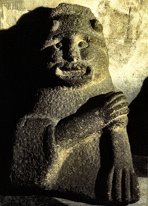
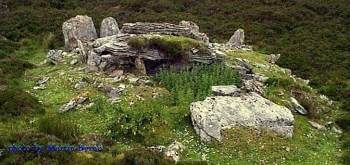

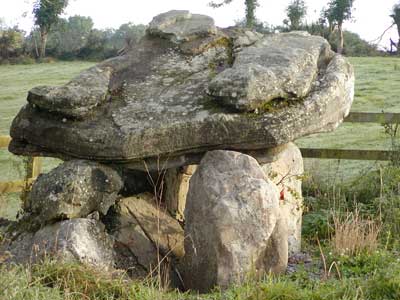
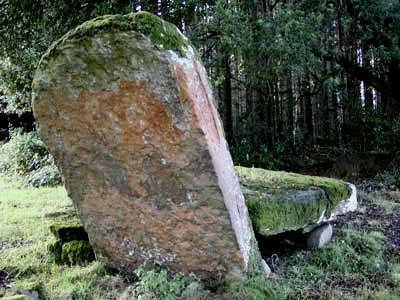
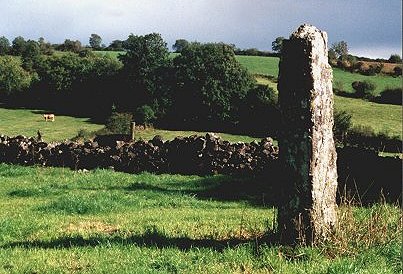
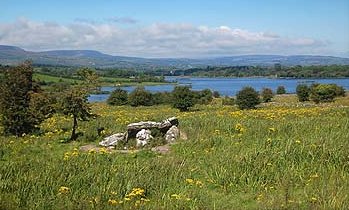
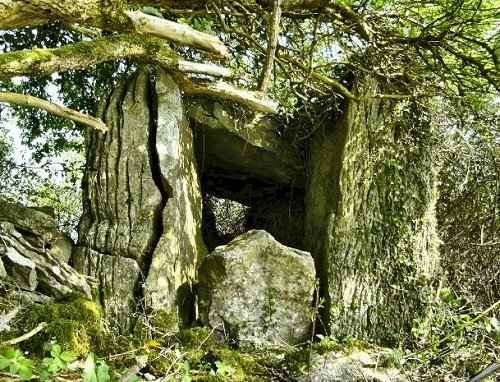
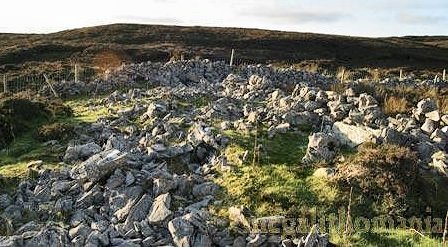
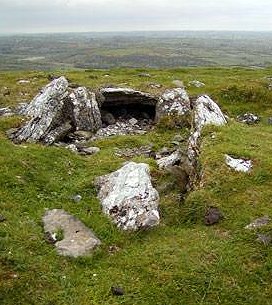
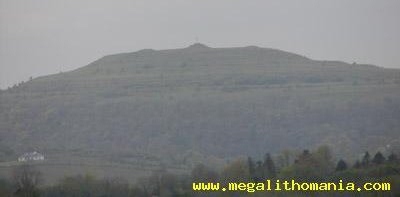
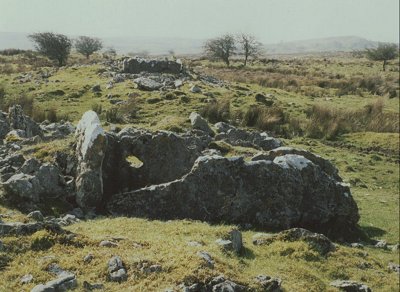 click
for more photographs
click
for more photographs